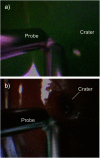Towards Practical Endoscopic Mass Spectrometry
- PMID: 28852605
- PMCID: PMC5572716
- DOI: 10.5702/massspectrometry.S0070
Towards Practical Endoscopic Mass Spectrometry
Abstract
In this paper, we briefly review the remote mass spectrometric techniques that are viable to perform "endoscopic mass spectrometry," i.e., in-situ and in-vivo MS analysis inside the cavity of human or animal body. We also report our experience with a moving string sampling probe for the remote sample collection and the transportation of adhered sample to an ion source near the mass spectrometer. With a miniaturization of the probe, the method described here has the potential to be fit directly into a medical endoscope.
Keywords: ambient ionization; endoscopy; in-situ and in-vivo analysis; moving sampling string; remote mass spectrometry.
Figures









References
-
- 1) R. Richards-Kortum, E. Sevick-Muraca. Quantitative optical spectroscopy for tissue diagnosis. Annu. Rev. Phys. Chem. 47: 555–606, 1996. - PubMed
-
- 2) G. J. Tearney, M. E. Brezinski, B. E. Bouma, S. A. Boppart, C. Pitris, J. F. Southern, J. G. Fujimoto. In vivo endoscopic optical biopsy with optical coherence tomography. Science 276: 2037–2039, 1997. - PubMed
-
- 3) Y. S. Sabharwal, A. R. Rouse, L. Donaldson, M. F. Hopkins, A. F. Gmitro. Slit-scanning confocal microendoscope for high-resolution in vivo imaging. Appl. Opt. 38: 7133–7144, 1999. - PubMed
-
- 4) V. Backman, M. B. Wallace, L. T. Perelman, J. T. Arendt, R. Gurjar, M. G. Müller, Q. Zhang, G. Zonios, E. Kline, T. McGillican, S. Shapshay, T. Valdez, K. Badizadegan, J. M. Crawford, M. Fitzmaurice, S. Kabani, H. S. Levin, M. Seiler, R. R. Dasari, I. Itzkan, J. Van Dam, M. S. Feld. Detection of preinvasive cancer cells. Nature 406: 35–36, 2000. - PubMed
-
- 5) T. F. Massoud, S. S. Gambhir. Molecular imaging in living subjects: Seeing fundamental biological processes in a new light. Genes Dev. 17: 545–580, 2003. - PubMed
LinkOut - more resources
Full Text Sources
Other Literature Sources

